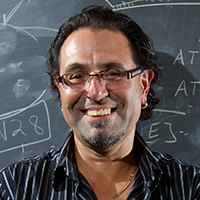Growing up in a family of machinists, Carlos Catalano was fascinated by the inner workings of devices. Wrist watches, especially, weren’t safe around the family home in Southern California.
“I used to take watches apart to see how they worked. I’d never get them back together,” Catalano, PharmD, PhD, professor of pharmaceutical sciences at the Skaggs School of Pharmacy and Pharmaceutical Sciences, said with a chuckle. “I just had a general interest in how things work.”
|
About AB Nexus AB Nexus, an initiative launched in 2020, has provided $2 million to 30 collaborative intercampus teams that feature scientists, engineers and physicians at CU Boulder and the CU Anschutz Medical Campus. The program has proved to be a catalyst for bringing researchers together to tackle innovative projects, enabling them to gather data needed for success in their pursuit of extramural funding from NIH and other funding agencies. |
Later, when he became the first member of his family to attend college, Catalano developed an interest in biochemistry and pharmacy. Ever since, he has researched the inner workings of viruses and nanoparticles. His research has been continuously funded by the National Institutes of Health (NIH) and the National Science Foundation for over 30 years.
“We’ve looked at virus assembly, and we do fundamental studies – biochemistry, biophysics, enzymology and structure,” he said. “We use a bacteriophage, which is a virus that infects a bacteria, and try to figure out how it works.”
Catalano is collaborating with Theodore Randolph, PhD, of the Department of Chemical and Biological Engineering at CU Boulder, to develop novel, controlled-release formulations of bacteriophages for the treatment of osteomyelitis, a deep-bone tissue injury. The project received an AB Nexus award last spring; AB Nexus is a program that encourages CU Anschutz and CU Boulder scientists to collaborate on innovative research.
During his CU career – he also spent eight years at the University of Washington – Catalano has been a leading student mentor, serving as faculty advisor to the CU Anschutz student chapter of the Society for the Advancement of Chicanos and Native Americans (SACNAS) and co-director (with Eduardo Davila, PhD, professor of medicine-medical oncology) of the CU Anschutz PIKE-PREP, a NIH-funded program to recruit and train post-baccalaureate diversity students for successful careers in science.
In the following Q&A, Catalano talks about developing his love for research, his current AB Nexus project and why it’s important to foster diverse approaches to science. The interview has been edited for clarity and concision.





